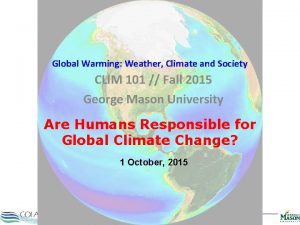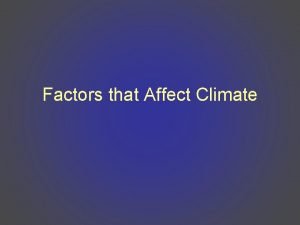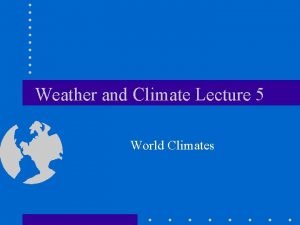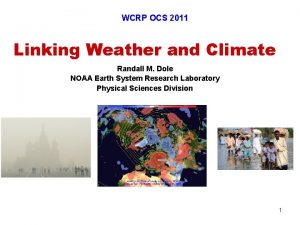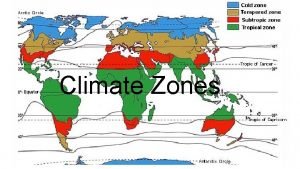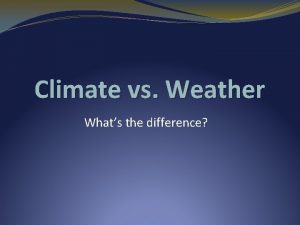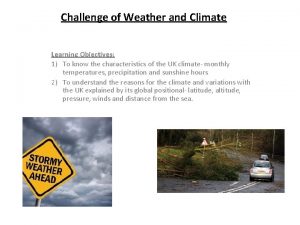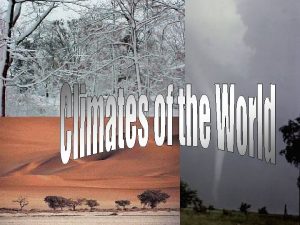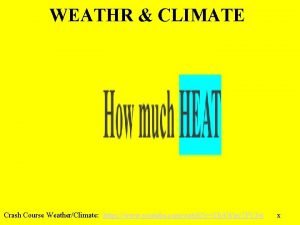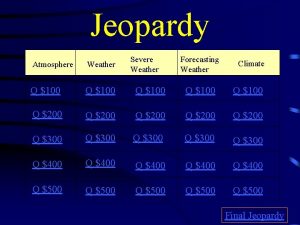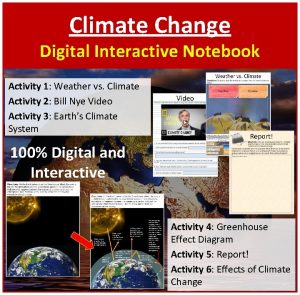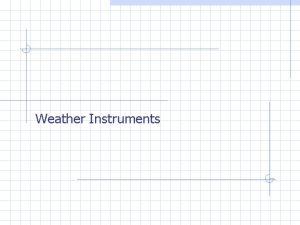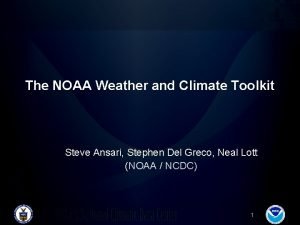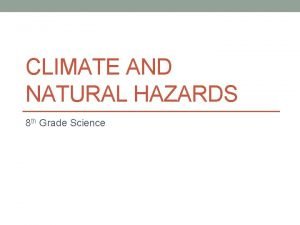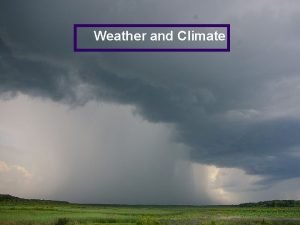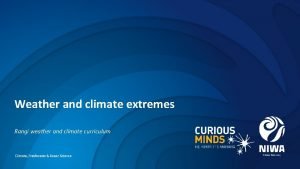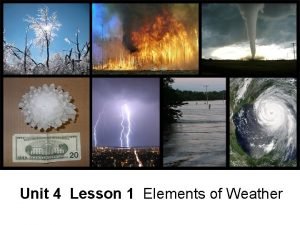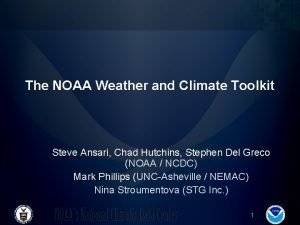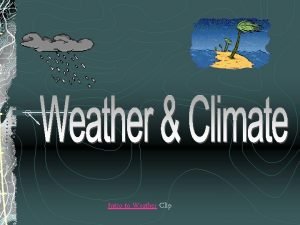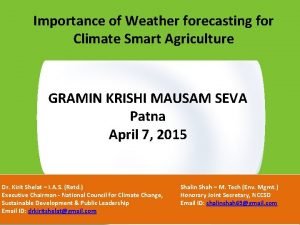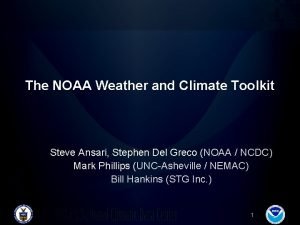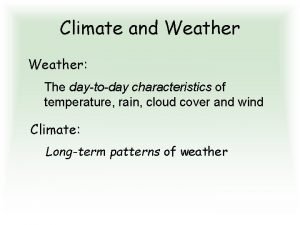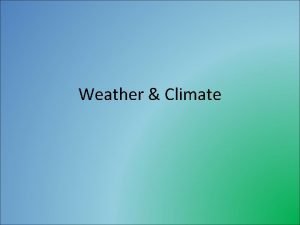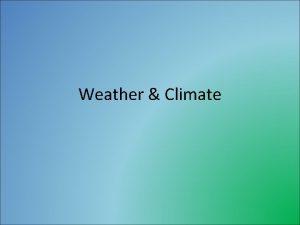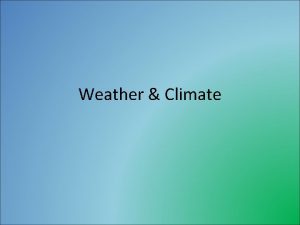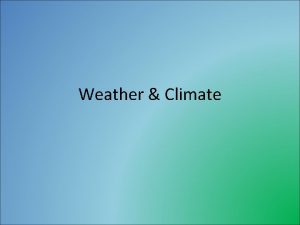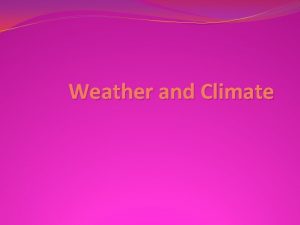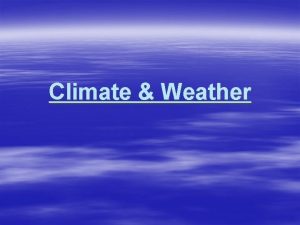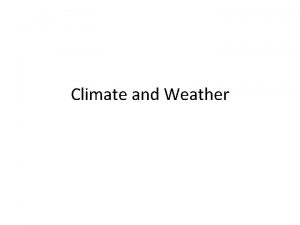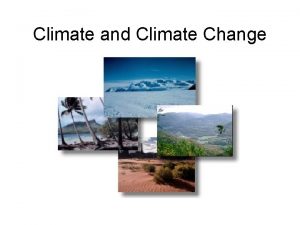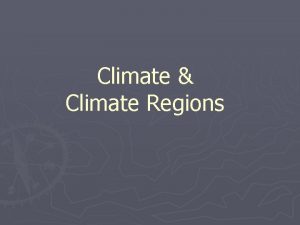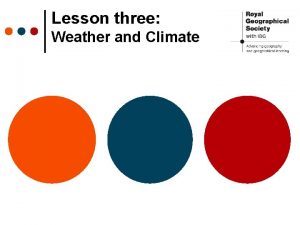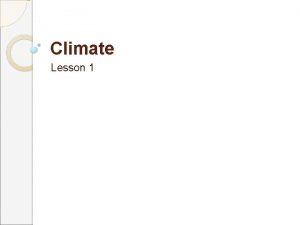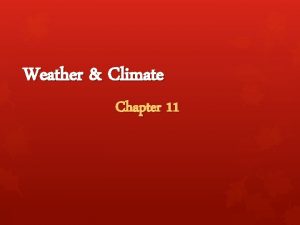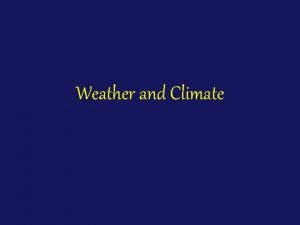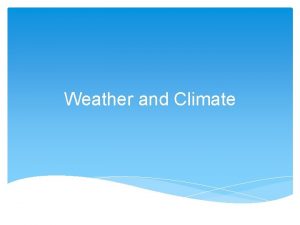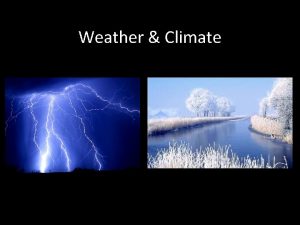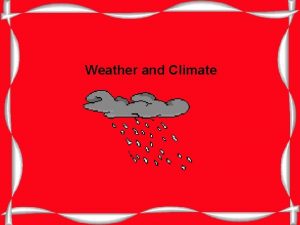Lesson Plan Climate vs Weather Summary This lesson



































- Slides: 35

Lesson Plan – Climate vs. Weather Summary This lesson will explain what climate is (as opposed to weather) and discuss factors about the earth’s position and rotation that influence the climate. Other factors affecting climate and why the earth is getting warmer will be discussed. A hands-on, in classroom activity will reinforce concepts of this lesson. Content Area Earth Science Grade Level 5 -8 Key Concept(s) • Climate and weather are two different things. Climate describes long term patterns of weather in regions based on distance from equator, distance from ocean, ocean currents, prevailing winds, and topography. • Earths heat budget also affects climate and depends on how much heat from the sun is reflected or absorbed.

Lesson Plan – Climate vs. Weather Key Concept(s) • Climate is also affected by the shape of earths orbit, the tilt of earth’s axis, and the wobble of earth’s rotation. Objectives Students will be able to: • Explain the difference between climate and weather. • Explain why earth’s ice caps are an important factor in balancing the earth’s heat and climate. • Understand how different geologic and oceanic features influence the climate in different regions of the earth. • Understand the relative size difference between sun, earth, and moon. • Understand how the shape of the earth’s orbit, the tilt of earths axis, and the wobble of earth’s rotation influence earth’s climate.

Lesson Plan – Climate vs. Weather Resources NOAA sites for climate and weather information and education materials. http: //www. noaa. gov/education https: //www. climate. gov http: //www. weather. gov GCOOS climate associated maps to show current weather and warnings in the Gulf of Mexico. Maps and data also depict what parameters are measured by remote equipment (can discuss benefits to short and long term data). This product also has maps that depict sea level rise scenarios. https: //products. gcoos. org/search

Lesson Plan – Climate vs. Weather National Science Education Standard or Ocean Literacy Essential Principle Learning Goals Unifying Concepts and Processes 1. Systems, order, and organization A system is an organized group of related objects or components that form a whole. Systems can consist of organisms, machines, fundamental particles, galaxies, ideas, numbers, and education. Systems have boundaries, components, resources flow (input and output), and feedback. Unifying Concepts and Processes 2. Evidence, models, and explanation Models are tentative schemes or structures that correspond to real objects, events, or classes of events, and that have explanatory power. Models help scientists and engineers understand how things work.

Lesson Plan – Climate vs. Weather National Science Education Standard or Ocean Literacy Essential Principle Learning Goals Unifying Concepts and Processes 3. Change, constancy, and measurement Changes might occur, for example, in properties of materials, position of objects, motion, and form and function of systems. Interactions within and among systems result in change. Changes vary in rate, scale, and pattern, including trends and cycles. Science as Inquiry A. 1. Abilities necessary to do scientific inquiry. Use mathematics in all aspects of scientific inquiry. Mathematics is essential to asking and answering questions about the natural world. Mathematics can be used to ask questions; to gather, organize, and present data; and to structure convincing explanations.

Lesson Plan – Climate vs. Weather National Science Education Standard or Ocean Literacy Essential Principle Learning Goals Science as Inquiry A. 2. Understandings about scientific inquiry Different kinds of questions suggest different kinds of scientific investigations. Some investigations involve observing and describing objects or events; some involve experiments; some involve seeking more information; some involve discovery of new objects and phenomena; and some involve making models. Earth and Space Science D. 2. Structure of the earth system Clouds, formed by the condensation of water vapor, affect weather and climate. Global patterns of atmospheric movement influence local weather. Oceans have a major effect on climate, because water in the oceans holds a large amount of heat.

Lesson Plan – Climate vs. Weather National Science Education Standard or Ocean Literacy Essential Principle Learning Goals Earth and Space Science D. 3. Earth is the solar system The sun is the major source of energy for phenomena on the earth’s surface, such as growth of plants, winds, ocean currents, and the water cycle. Seasons result from variations in the amount of the sun’s energy hitting the surface, due to the tilt of the earth’s rotation on its axis and the length of the day. Principle 3 (6 -8: A. , A. 10. , A. 12. ) The ocean is a major influence on weather and climate. The interaction of oceanic and atmospheric processes controls weather and climate by dominating Earth’s energy system. A. The ocean moderates global weather and climate by absorbing most of the solar radiation reaching earth. A. 10. Short-term and seasonal changes in ocean temperature can affect rainfall and temperatures on land (i. e. weather). Long-term changes in ocean temperature can affect the climate. A. 12. Long term weather and oceanographic data sets contribute to climate predictions.

Climate or Weather? What’s the difference?

Climate Longer time scales Weather Shorter time scales

Another way to think about it… Climate is what you expect… • A very hot summer in July based on average of weather over time and space. Weather is what you get… • A rainy afternoon. • It’s how the atmosphere is behaving NOW or in the short term of minutes-to-months. We think of weather in terms of things like: • Brightness • Cloudiness • Humidity • Precipitation • Temperature • Visibility/fog • Wind…

Climate is affected by Earth’s Heat Budget Remember that science is all about ENERGY? Heat is another form of energy. • Where it’s coming from… • Where it’s going • How it’s changing…

The balance of heat entering and leaving Earth is one factor affecting the heat budget. Albedo is the Latin world for "whiteness“. It is used to describe how much sunlight is reflected from the surface of Earth.

Snow and ice reflect more heat back to space than soil and water. Figuring out the heat budget is complicated. Think about this: Ice on Earth melts Land below the ice now absorbs more heat than the ice did. What happens to the temperature on Earth? What happens to the remaining ice?

The idea of “tipping points” If you guessed • Temperature increases • Ice melts faster You are correct! How much ice can Earth lose before planetary temperature is too hot for water to freeze? Should we care? First we’ll investigate some driving forces of climate. During the year, we’ll explore many reasons why we should care and what we can do to deal with “tipping. ”

Activity: Investigating aspects of the earth’s rotation around the sun that affect or “drive” the earth’s climate. This activity will utilize a model to demonstrate how the shape of the earths rotation around the sun (it is not a perfect circle, but close!), the tilt of the earth’s axis, and the wobble of earth’s spin drive changes in the earth’s climate. Materials: • Three circles (each a different color): 1 measuring 30 cm (sun) 1 measuring 8 cm (earth) 1 measuring 2 cm (moon) • 1 Piece of yarn (approximately 150 cm or 1. 5 m) • Ruler • Pencil, marker • Foam balls (Approximately 2” diameter or larger) • Lollipop sticks or small wooden skewers (for earths axis) • Spinning top (multiple if possible) Procedure and explanations on following slides:

So, what affects Earth’s albedo (how much solar energy is reflected back to space compared to how much Earth receives)? • Today, we will investigate three of these ‘drivers’ of Earth’s climate. • We will start by removing the items in your Ziploc bag (you each get one orange, one blue and one yellow circle and 1 piece of yarn). • Notice the size of each. What do you think each circle represents?

Label each of the three circles with a pencil or marker. When you are done, your circles should look like this. Sun Earth Moon Measure the diameter of each circle in centimeters. Write the number you measure on the appropriate circle. Calculate this: The moon is about ____% the size of Earth.

Use the “is” over “of” trick to help solve for per cent. The trick is that the “is” goes in the numerator (top) and the “of” goes in the denominator (bottom: Moon 2 cm Earth 8 cm Calculate this: The moon is about ____% the size of Earth.

Approximate diameter measurements for your circles are: Sun 30 cm Earth 8 cm Moon 2 cm If the diameter of the Moon is 2 cm and the diameter of Earth is 8 cm: 2 8 ( as a fraction 2/8) = 0. 25 As a per cent: 0. 25 x 100 = 25%. The diameter of the Moon is about ¼ the size of the Earth. Using more realistic diameters of the moon (3, 500 km) and Earth (12, 700 km), the more exact number is closer to 27%, but you get the idea!

How does the diameter of the Sun compare to that of earth? • In our activity, the Sun is only about 4 x the size of Earth because it has to fit on your desk! • In reality, the diameter of the Sun is about 100 X greater than that of Earth. • If our Earth is 8 cm, what is 100 x this diameter measured in centimeters? • Let’s go outside and see what this number looks like compared to our 8 cm Earth! Sun > Earth > Moon

Other ways to consider 800 cm: 2. 4 cm = 1 inch 800 cm = 800/ 2. 4 = 315 inches 12 inches = 1 ft 315 inches = 315/12 27 feet 3 ft = 1 yard: 27/3 = 9 yards … that’s how much fabric we used! The longest known fabric banner was 7. 8 km. It was made for a 1938 parade in Spain to celebrate the opening of a World Cup stadium! That’s 8, 530 yards… about 950 X longer than ours!

How do we measure time? One Day One Month The time it takes the Earth The time it takes the moon to spin around on its axis to orbit the Earth one complete time (24 hours). time (27 days). One Year The time it takes Earth to complete one orbit around the Sun (365 days).

Climate Driver #1: Changes in Earth’s orbit around the Sun Take your yarn and let’s investigate… 1. Lay the sun flat on your desk. 2. Make a circle with your yarn around the sun. 3. Place the Earth anywhere on the piece of yarn. 4. Measure the distance in centimeters from the center of your earth to the edge of the sun closest to it. Sun If you move the earth to another point along the circumference of the circle, will the distance to the sun change? Earth

Stretch your circle to make an ellipse around the sun. Sun Earth 1. Place the earth on the yarn at a position on the ellipse closest to the sun and measure the distance as before. 2. Move the earth to a point on the ellipse furthest from the sun and measure again.

Changes in Earth’s orbit around the sun Sun Earth When earth has an elliptical orbit, it is closer to the sun in one part of its orbit and further from the sun in another part of its orbit. The amount of solar energy reaching different parts of earth depends on its orbit. The fancy word for this is ECCENTRICITY. The shape of the orbit changes on cycles of about 100, 000 years.

Figure it out…what is the least amount of yarn we could have used to orbit our 30 cm sun? About 94 cm

Climate Driver #2: Climate change also results from changes in the tilt of the Earth. • Imagine the Earth is a lollipop. The stick running through the lollipop is Earth’s (imaginary) axis. • The parts of the Earth that tilt toward the Sun get hotter than the parts away from it. • We will use the foam balls and lollipop sticks to make Earth on its axis. We will draw the equator to show the planet is divided into halves or hemispheres.

Next we will draw two more “special” lines of latitude circling the globe. • The equator is latitude 0. • Latitude 23. 5 North is called the Tropic of Cancer • Latitude 23. 5 South is called the Tropic of Capricorn. They are special because they are the greatest distances north and south in Earth’s tilt pattern where the sun may appear directly overhead.

Where in Earth’s tilt pattern? • Solstices • Summer solstice is around Jun 21. It is when the sun’s rays are directly overhead the Tropic of Cancer —we get our longest daylight hours of the year. • Winter solstice is around Dec. 21. We get the fewest hours of sunlight while those along the Tropic of Capricorn get their longest days. • Equinoxes • Vernal equinox (start of spring) is around March 21. It is when Earth’s axis is straight compared to the sun. The sun’s rays are directly over the equator.

Winter in the Northern Hemisphere Summer in the Northern Hemisphere The North Pole is tilted away from the Sun. The North Pole tilts toward the Sun. The tilt is what gives Earth its four seasons (spring, summer, winter, fall). Seasons are opposite in the two hemispheres. While we enjoy summer in the Northern Hemisphere, our neighbors in the Southern Hemisphere are experiencing winter. One cycle of Earth’s tilt pattern takes about 41, 000 years!

Climate Driver #3: Climate change is also influenced by changes in the wobble of the Earth (called precession). • Think of the Earth as a spinning top. • Does the top stay on one place? • What happens as a spinning top slows down? Spin the writing top on a page in your data book. If you don’t have one, use a regular top and a pencil. Observe the path the top takes as it spins. Is there one point on the page or a spiral? This is how the Earth wobbles as it spins!

Changes in Earth’s wobble affect when a particular season will occur and how different the seasons will be. Sun Earth WINTER Earth SUMMER • There are points in Earth’s wobble where Northern Hemisphere winters occur when Earth is farthest from the Sun Ear • Summer solstices occur when Earth is closest to the Sun. • This can result in winters that are colder than usual and summers that are warmer than usual. The fancy name for this winter position is APHELION and summer position is PERIHELION. • “Helios” = Greek for god of the sun. • “peri” = Greek for near • “apo” = Greek for away Earth completes one full cycle of “wobble” about every 26, 000 years.

The climate drivers we investigated are called the Milankovitch Cycles Other factors also influence Earth’s climate. – The amount and type of gas in the atmosphere – Motion of tectonic plates (because their positions affect wind and ocean currents). – Volcanic activity

Changes in Orbit About 100, 000 year cycle MILUTIN MILANKOVIĆ (1879 - 1958) Changes in Tilt About 41, 000 year cycle Changes in Wobble About 26, 000 year cycle Serbian

Lesson developed by Dr. Chris Simoniello for Bay Point Elementary. Standards-crossreferencing and formatting by Grant Craig. Questions, comments, edits? Contact Dr. Chris: chris. Simoniello@gcoos. org
 Climate change 2014 mitigation of climate change
Climate change 2014 mitigation of climate change Micro lesson plan
Micro lesson plan World geography chapter 3 weather and climate
World geography chapter 3 weather and climate Clim 101
Clim 101 How do prevailing winds affect climate
How do prevailing winds affect climate Weather and climate similarities
Weather and climate similarities Conclusion of weather and climate
Conclusion of weather and climate 12 climate zones map
12 climate zones map Whats the difference between weather and climate
Whats the difference between weather and climate Objectives of weather and climate
Objectives of weather and climate Climate vs weather
Climate vs weather Weathr today
Weathr today Tropical climate
Tropical climate Brainpop weather
Brainpop weather Weather and climate jeopardy
Weather and climate jeopardy Weather and climate interactive activities
Weather and climate interactive activities Instruments used to measure weather and climate
Instruments used to measure weather and climate Rains proff
Rains proff Clothes poem
Clothes poem Noaa weather and climate toolkit
Noaa weather and climate toolkit Explain how some hail can become baseball sized
Explain how some hail can become baseball sized Stevenson screen unit of measurement
Stevenson screen unit of measurement Kahoot quiz
Kahoot quiz Elements of weather
Elements of weather Weather and climate toolkit
Weather and climate toolkit Brainpop1
Brainpop1 Contingent crop planning slideshare
Contingent crop planning slideshare Venn diagram of heat and electricity
Venn diagram of heat and electricity Noaa wct
Noaa wct Lowern
Lowern Weather forecast lesson 3 outline answers
Weather forecast lesson 3 outline answers Weather symbols for station models
Weather symbols for station models Tongue twisters about winter
Tongue twisters about winter Noun of windy
Noun of windy Whether the weather
Whether the weather Heavy weather by weather report
Heavy weather by weather report



